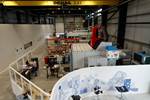Falcon Heavy slated for lift-off Feb. 6
Launch of the SpaceX Falcon Heavy rocket is scheduled for 1:30 p.m. ET on Feb. 6 and represents the largest rocket launch attempt since the Saturn V in 1973.
SpaceX (Hawthorne, CA, US) reports that the first test flight of its Falcon Heavy is targeted for Tuesday, Feb. 6 at 1:30 p.m. ET from Launch Complex 39A at Kennedy Space Center in Florida. When Falcon Heavy lifts off, it will be the most powerful operational rocket in the world by a factor of two.
With the ability to lift into orbit nearly 64 MT/141,000 lb — a mass greater than a 737 jetliner loaded with passengers, crew, luggage and fuel — Falcon Heavy can lift more than twice the payload of the next closest operational vehicle, the Delta IV Heavy, at one-third the cost.
The composites-intensive Falcon Heavy draws upon the proven heritage and reliability of the SpaceX Falcon 9. Its first stage is composed of three Falcon 9 nine-engine cores whose 27 Merlin engines together generate more than 5 million lb of thrust at liftoff, equal to approximately 18 747 aircraft. Only the Saturn V moon rocket, last flown in 1973, delivered more payload to orbit. Falcon Heavy was designed from the outset to carry humans into space and restores the possibility of flying missions with crew to the Moon or Mars.
Check out CW Talks: The Composites Podcast interview with Coastal Enterprises’ Chuck Miller to hear his memories of working on the Saturn V rocket.
Related Content
-
Combining multifunctional thermoplastic composites, additive manufacturing for next-gen airframe structures
The DOMMINIO project combines AFP with 3D printed gyroid cores, embedded SHM sensors and smart materials for induction-driven disassembly of parts at end of life.
-
Welding is not bonding
Discussion of the issues in our understanding of thermoplastic composite welded structures and certification of the latest materials and welding technologies for future airframes.
-
Plant tour: Collins Aerospace, Riverside, Calif., U.S. and Almere, Netherlands
Composite Tier 1’s long history, acquisition of stamped parts pioneer Dutch Thermoplastic Components, advances roadmap for growth in thermoplastic composite parts.






